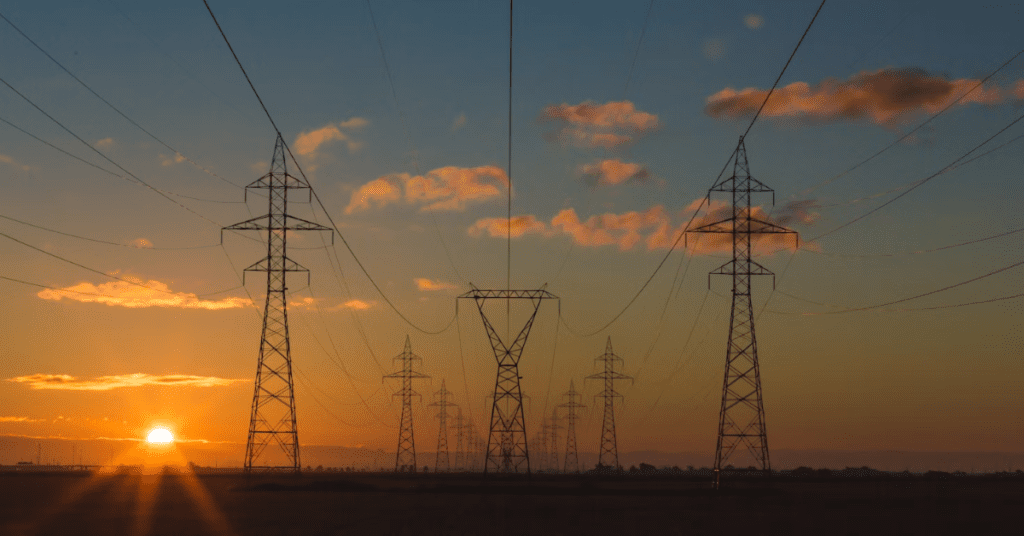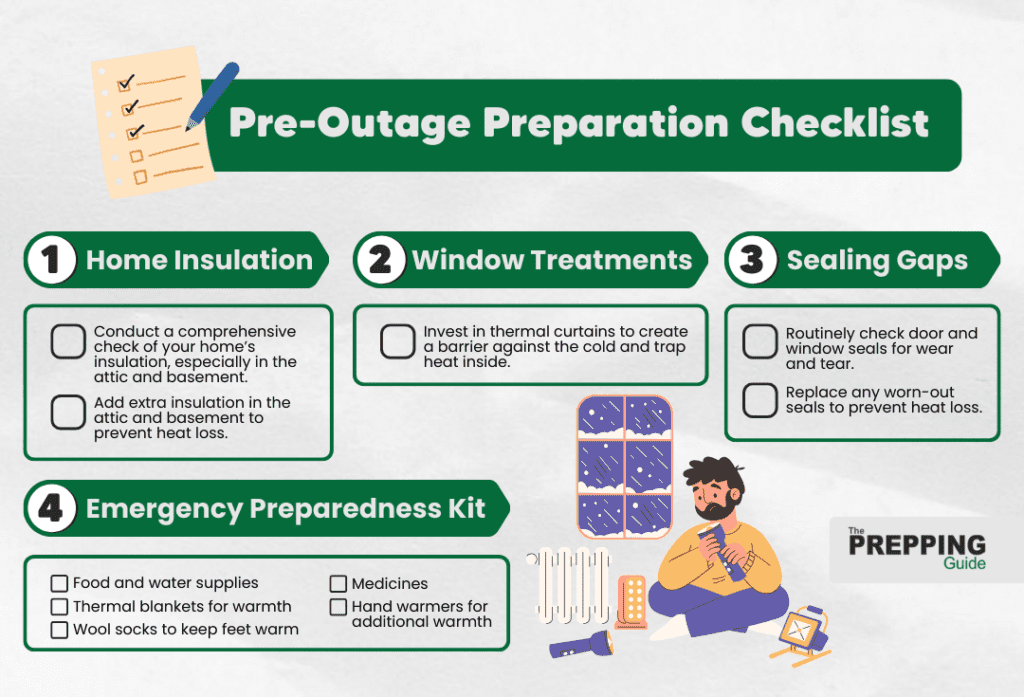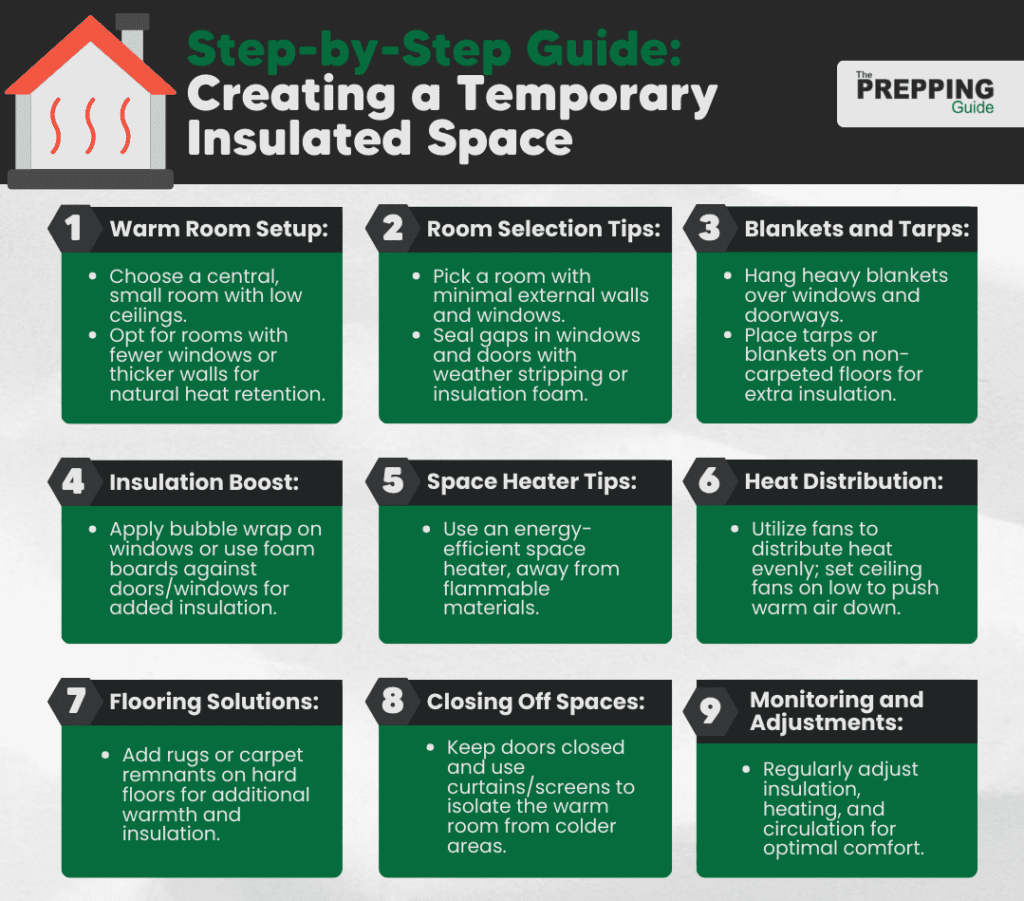When disaster strikes, and the power goes out, staying warm is essential for your comfort and safety. For those who believe in being prepared for anything, it’s crucial to know the best alternative heat sources for power outages.
Key Takeaways:
- Alternative heat sources for power outages include using wood-burning stoves, portable propane heaters, or even generating warmth from candles and blankets.
- Selecting an alternative heat source isn’t just about what’s available; it’s about matching your specific needs to the options at hand.
- Creating a warm room or a temporary insulated space involves strategically insulating it to prevent heat loss.
- Learning about carbon monoxide safety is critical to avoid CO poisoning.
This article takes a closer look at various options beyond typical heating systems, ensuring you’re equipped with practical solutions to keep you cozy during unexpected outages.
The Risks of Power Outages

Power outages introduce various challenges and hazards, especially during severe weather conditions. Initially, losing electricity disrupts daily activities and leads to immediate issues such as spoiled food and loss of communication, heightening risks during emergencies.
This loss of power can also hinder access to essential information about the ongoing crisis, complicate medical care for those reliant on electrically powered health devices, and reduce the effectiveness of security systems, thereby increasing vulnerability to safety threats. Furthermore, the absence of lighting at night can lead to accidents and reduce overall personal safety, creating a more stressful environment for everyone affected.
The lack of heating becomes particularly concerning in colder climates. In these situations, indoor temperatures can drop swiftly, increasing the risk of hypothermia—a condition where the body temperature falls to dangerously low levels. This can cause serious health problems, including potential failure of the heart and respiratory systems.
According to the Centers for Disease Control and Prevention (CDC):
“Hypothermia is caused by prolonged exposures to very cold temperatures. When exposed to cold temperatures, your body begins to lose heat faster than it’s produced. Lengthy exposures will eventually use up your body’s stored energy, which leads to lower body temperature.”
Preparing Your Home for a Power Outage
“An ounce of prevention is worth a pound of cure,” as the saying goes, and it couldn’t be more true when it comes to preparing your home for a power outage. Here’s what you can do well in advance:
1. Insulate, Insulate, Insulate: Focus on keeping the heat you have inside. Insulating your home isn’t just a winter task; it’s a year-round necessity. Start with a comprehensive check of your home’s insulation, particularly in the attic and basement. These areas are often the primary sources of heat loss. Adding extra insulation here can keep heat from escaping.
2. Window Treatments: Invest in thermal curtains designed to create a barrier against the cold and trap heat inside. Keepping these curtains closed during a power outage can significantly help maintain your home’s temperature.
3. Seal the Gaps: Door and window seals are easy to overlook until a chilly draft shows their significance. Before winter, make it a habit to inspect and replace any worn-out seals. This simple step can greatly reduce heat loss.
4. Emergency Kits: Always keep an emergency preparedness kit ready. In addition to essentials like food and water, include items for warmth like thermal blankets, wool socks, and hand warmers. These items can be lifesavers during power outages when the temperature is falling.

Top Alternative Heat Sources for Power Outages
Knowing how to prepare for a power outage is important, but finding reliable ways to stay warm without electricity is also crucial. Here’s a list of the best alternative heat sources for emergencies:
Wood Burning Stoves or Fireplaces
Nothing compares to the cozy warmth of a wood-burning stove or fireplace. Not only do they provide heat, but the flickering flames also boost morale on cold, dark nights. They can be highly effective if you have access to a steady wood supply. Just remember to ventilate properly to prevent carbon monoxide buildup and ensure you have dry, ready-to-use firewood.
Propane Heaters
Portable propane heaters are great for heating individual rooms during a power outage. They often have safety features to prevent carbon monoxide poisoning, but ventilation is important. Always follow the manufacturer’s safety instructions and never leave these heaters unattended.
Kerosene Heaters

Kerosene heaters are another solid choice for emergency heating. They’re efficient and can heat up a room quickly. However, like with any combustion heater, ventilation is crucial to avoid the accumulation of harmful gases. Also, always store kerosene in a well-marked container and outside your living space to prevent accidental contamination or fire hazards.
Gas-Powered Generators (for running electric heaters)
A gas-powered generator can be a lifeline during a power outage for heating and keeping essential appliances running. When using a generator to power electric heaters, ensure it’s operated outside and far away from windows or vents to prevent carbon monoxide poisoning. Generators are a more complex solution but offer the flexibility of powering various devices.
Candle-Powered Heaters
While not the most effective for heating large spaces, candle-powered heaters can provide a surprising amount of warmth in small, enclosed areas. They work by trapping and concentrating the heat from candles, usually using terracotta pots or other materials that retain heat. This method is more about personal warmth and can be a creative solution in a pinch.
Solar Heaters
For those who plan ahead, solar heaters can be a sustainable and effective way to heat your home during a power outage, provided there’s sufficient sunlight. They range from professional installations that integrate into your home’s heating system to DIY solutions that capture and distribute solar heat. The initial setup can be costly or labor-intensive, but the long-term benefits and independence from the grid are significant advantages.
Pellet Stoves

Pellet stoves offer a more modern and efficient alternative to wood stoves, burning compressed wood or biomass pellets. They’re known for their efficiency and ease of use, with some models equipped with battery backups to ensure functionality during power outages. While pellets must be stored dry and are an additional expense, the consistent and controlled heat output makes them popular.
Battery-Powered Electric Blankets
For personal warmth, battery-powered electric blankets are a godsend. They provide direct, comforting warmth without needing a heat source to warm up an entire room. Ideal for sleeping or relaxing during a cold outage, these blankets are an efficient way to stay warm without heating the whole house.
Portable Gas Camp Stoves (for small, well-ventilated areas)
While primarily used for cooking, portable gas camp stoves can also provide heat in small, well-ventilated areas. It’s crucial to ensure ventilation to prevent carbon monoxide buildup and use them cautiously, as they’re not designed primarily as heat sources.
Alcohol Heaters
Alcohol heaters, often DIY solutions involving isopropyl alcohol and safe burning containers, can be an emergency heat source. While they won’t heat a large space, they can provide warmth and comfort in close quarters. Always use caution with open flames and ensure adequate ventilation.
Here’s a more in-depth comparison for your guide:

How to Choose the Right Alternative Heat Source for Your Home
Selecting an alternative heat source isn’t just about what’s available; it’s about matching your specific needs to the options at hand. Consider these critical factors:
Size of the Space
It’s not just the size of the room but also its layout and how heat moves within it. Open floor plans may need different heating solutions than compartmentalized spaces. For instance, a wood-burning stove might work well in open areas because it spreads heat evenly, while electric space heaters could be better for smaller, enclosed rooms.
Availability of Ventilation
Any heater that burns fuel, whether wood, propane, or kerosene, must have a way to vent out the fumes produced. This might involve installing chimney pipes for wood stoves or ensuring windows can be safely cracked open when using kerosene heaters. Finding a balance between getting fresh air and keeping the cold out is important.
Fuel Storage Requirements
Different types of fuel have their own requirements. Wood needs dry storage and protection from the weather, while propane and kerosene should be stored in designated containers away from the house to reduce the risk of fire or explosion. Also, consider fuel availability during longer outages. Balancing the amount you store with safety and space constraints can be challenging.
Initial Installation and Long-term Maintenance Costs
The initial cost of installing alternative heating systems can range widely from affordable electric heaters to pricier geothermal heat pumps. However, it’s crucial to consider the long-term operation and upkeep expenses. Geothermal systems may have higher upfront costs but usually result in lower energy bills over time because of their high efficiency.
Maintenance needs also affect the overall cost-effectiveness of a heating system. Wood-burning stoves need chimney cleaning to prevent fires, while solar heating systems require minimal upkeep, mainly keeping solar panels clean for best performance.
Personal Comfort and Control
Your comfort preference plays a crucial role in choosing the right heating system. Some people prefer the radiant heat provided by a wood stove or a hydronic radiant floor heating system, which offers even heat distribution and a cozy feel. Others might prioritize the convenience and temperature control programmable thermostats offered in electric or gas heating systems. Consider systems that allow you to adjust the temperature easily and possibly even control different zones in your home to ensure comfort in areas where you spend the most time.
How to Create a Temporary Insulated Space: Step-by-step Guide
Creating a warm room or a temporary insulated space requires more than just choosing a room; it involves strategically insulating it to prevent heat loss. Here’s how to approach it:

1. Setting Up a Warm Room
The concept of a warm room is to create a micro-environment within your home that is easier and more efficient to heat. Begin by selecting a room based on its central location, smaller size, and lower ceiling as heat rises. Consider rooms that naturally retain heat better due to fewer windows or thicker walls.
2. Picking a Small Room or Area to Insulate and Heat
Choose a room with the least external walls and windows. Smaller rooms are easier to keep warm and maintain. Opt for a space that retains natural warmth, such as a kitchen or an internal living area.
Once the room is selected, assess its windows and doors for drafts. Use weather stripping or insulation foam to seal gaps. Remember, the goal is to create an airtight space that minimizes heat escape.
3. Using Blankets and Tarps to Minimize Heat Loss
Beyond sealing gaps, consider hanging heavy blankets or curtains over windows and doorways as extra insulation. Insulating your chosen room can be done effectively with items around the house.
Hang blankets over windows and doorways to trap heat. Place tarps or blankets on the floor if it’s not carpeted to add another layer of insulation. These simple steps can significantly reduce heat loss and keep the warm room comfortable.
4. Enhancing Insulation with Bubble Wrap or Foam Boards
If your windows are still letting out too much heat even after covering them with blankets, consider using bubble wrap or foam insulation boards to increase insulation. Here’s how to do it:
Bubble Wrap
1. Cut the bubble wrap to the size of the window panel.
2. Moisten the window glass slightly with water using a spray bottle or damp cloth.
3. Press the flat side of the bubble wrap against the wet glass.
4. Ensure the bubble wrap adheres smoothly to create an air pocket that traps heat while allowing light to pass through.
Foam Insulation Boards
1. Measure the area of the window or door you want to cover using foam insulation boards.
2. Cut the foam insulation board to fit these dimensions accurately.
3. Place the cut boards against less frequently used doors or windows to add a sturdy, insulative layer.
4. Utilize this method for areas of the home where visibility or light access is not crucial.
Both methods are cost-effective and easily reversible. You can remove the bubble wrap and foam boards whenever you no longer need the extra insulation, making this a flexible option for managing heat loss during cold periods.
5. Strategic Use of Space Heaters

A space heater can be a good investment for your warm room if additional heating is necessary. Choose an energy-efficient model appropriate for the room’s size. Place it away from flammable materials and use it only while the room is occupied. Remember to follow all safety instructions to prevent fire hazards. Using a space heater in conjunction with the room’s insulation will maximize warmth and energy efficiency.
6. Maximizing Heat Distribution
To ensure the distribution of heat within the room, use fans strategically. A ceiling fan set on low, with blades rotating clockwise, can help push warm air down from the ceiling without creating a draft. Portable fans can also be used to circulate warm air, especially if the heat source is localized (like a space heater). This helps avoid cold spots and maintains a consistent temperature throughout the room.
7. Temporary Flooring Solutions for Added Warmth
Adding rugs or carpet remnants can provide significant insulation for rooms with hard, cold floors. Thick rugs trap air, naturally insulating the room and keeping it warmer. If you’re using space heaters, rugs also help retain the heat emitted, making the environment cozier and more comfortable.
8. Closing Off Unused Spaces
Isolate the warm room from colder parts of the house by keeping doors closed. Use temporary barriers like curtains or screens to prevent warm air from escaping from open areas or hallways leading to the insulated room. This helps maintain the temperature of the warm room and reduces the heating requirement for the rest of the house.
9. Regular Monitoring and Adjustments
Finally, monitor the temperature and comfort level of the room regularly. Adjust the insulation, heating, and air circulation to maintain a comfortable environment. Be prepared to add or remove insulation layers or adjust the heater settings based on weather changes or the room’s occupancy.
Additional Safety Considerations During Power Outages

In unforeseen emergencies such as hypothermia and carbon monoxide poisoning, households must prioritize immediate and effective action to ensure safety. Here’s what should be done first in these critical situations:
For Hypothermia:
1. Seek Medical Help Immediately: Call emergency services if the person shows severe symptoms such as slurred speech, sluggishness, or confusion.
2. Move to a Warm Location: Bring the affected individual indoors or to a warmer environment as quickly as possible.
3. Insulate the Individual: Remove any wet clothing and wrap the person in warm blankets. Focus on warming the center of the body first (chest, neck, head, and groin) using skin-to-skin contact under loose, dry layers if necessary.
4. Provide Warm Beverages: If the person is conscious, offer warm, sweet beverages to help increase the body temperature, but avoid alcohol or caffeine.
For Carbon Monoxide Poisoning:
1. Get Fresh Air Immediately: Move the affected person to fresh air right away—either outside or by opening windows and doors.
2. Call Emergency Services: Dial emergency numbers to report suspected carbon monoxide poisoning, which can quickly become life-threatening.
3. Do Not Re-enter the Premises: Stay out of the affected area until emergency responders declare it safe.
4. Seek Medical Attention: Even if symptoms seem mild, it’s crucial to get checked by a medical professional, as carbon monoxide poisoning can rapidly worsen.
General First Aid and Immediate Actions:
- Stay Calm and Act Quickly: Maintaining calm helps manage the situation more effectively.
- Check for Danger: Before assisting others, ensure that the environment is safe for you to do so.
- Use First Aid Kits: If available and applicable, use items from a first aid kit to aid the affected individual until professional help arrives.
These initial steps are crucial in managing the effects of such emergencies and can significantly influence the outcomes. Always prioritize calling for professional medical help in these scenarios.
Conclusion
Preparing for power outages goes beyond just having candles and blankets on hand. It’s about understanding the risks, selecting the right alternative heat sources, and creating a warm, insulated space within your home. By taking proactive measures like enhancing insulation, strategically using heaters, and sealing off unused spaces, you can ensure your comfort and safety during unexpected outages.
Remember to prioritize carbon monoxide safety, regularly monitor and adjust your heating setup, and maintain an emergency preparedness plan. With these steps, you’ll be better equipped to weather any storm and keep your home warm when the power goes out.
FAQ
What is the best source of heat during a power outage?
The best source of heat during a power outage depends on your specific circumstances and the resources available. Wood-burning stoves or fireplaces are often considered reliable options due to their ability to provide consistent warmth and ambiance, but portable propane heaters and kerosene heaters can also be effective alternatives if used safely and with proper ventilation.
What is the cheapest way to heat a room?
Using natural gas or electric space heaters can be cost-effective, especially if the room is well-insulated and the heater is used sparingly. Maximizing insulation, sealing drafts, and utilizing passive solar heating techniques can also help reduce heating costs.
How can I ensure my alternative heat source is as efficient as possible?
Maximize efficiency by regularly cleaning and maintaining your heating unit, using quality fuel, only heating spaces that are actively used, and keeping doors closed to unused rooms.
